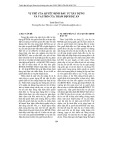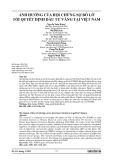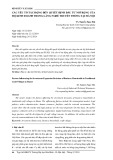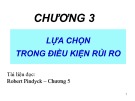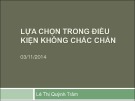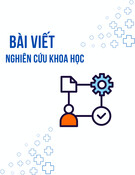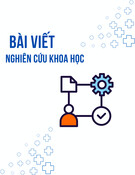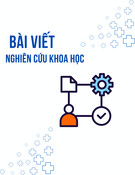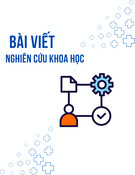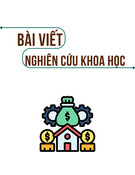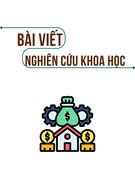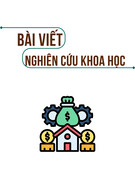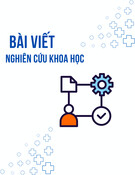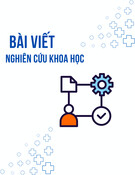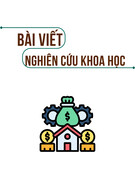
* Corresponding author Tel.: +98 218 8021067; fax: +98 218 8013102
E-mail address:mrabani@ut.ac.ir (M. Rabbani)
© 2019 by the authors; licensee Growing Science, Canada
doi: 10.5267/j.uscm.2018.7.002
Uncertain Supply Chain Management 7 (2019) 351–368
Contents lists available at GrowingScience
Uncertain Supply Chain Management
homepage: www.GrowingScience.com/uscm
Optimal decision problem in a three-level closed-loop supply chain with risk-averse players under
demand uncertainty
Safoura Famil Alamdara, Masoud Rabbania* and Jafar Heydaria
aSchool of Industrial Engineering, College of Engineering, University of Tehran, Tehran, Iran
C H R O N I C L E A B S T R A C T
Article history:
Received May 16, 2018
Accepted July 16 2018
Available online
July 17 2018
In this paper, a stochastic model of a closed-loop supply chain (CLSC) with one risk-averse
manufacturer, one risk-averse retailer and one risk-averse third party is developed. To analyze
how the members make decisions about wholesale price, collection rate, retail price and sales
effort under different decision-making structures, the optimal decision problem under
uncertain price and sales effort-dependent demand is studied through development of four
game theoretical models. The equilibrium results between various models are compared and
the optimal decisions from each member’s perspective are investigated. According to the
results, the third party-led model has better performance than manufacturer-led model. The
cooperation mode of manufacturer and retailer is beneficial for the whole chain and customers
and the cooperation mode of manufacturer and third party is the most effective model to collect
the used-product. Finally, to increase the performance of decentralized CLSC compared with
the centralized CLSC, a coordination contract is developed. The results indicate that this
contract is advantageous for the members of CLSC, the customers, and the environmental
issues.
ensee Growing Science, Canadac© 2018 by the authors; li
Keywords:
Closed-loop supply chains
Risk-averse
Collection effort
Sales effort
Game theory
Coordination contract
1. Introduction
Closed loop supply chain (CLSC) is defined as “from the perspective of the product total life cycle,
integrating the traditional forward supply chain activities and a set of additional activities of reverse
supply chain, i.e., designing, planning and controlling in the whole process from the acquisition and
production to redistribution, in order to recapture additional values” (Fleischmann et al., 1997; Guide
& Wassenhove, 2006). Due to increased environmental consciousness, environmental concerns and
strict environmental laws, CLSC management has become attractive for both business and academic
research throughout this decade (Prahinski & Kocabasoglu, 2006). CLSC has become an element that
companies must consider in decision-making processes concerning the design and development of their
supply chains (Rubio & Corominas, 2008). For instance, Xerox is a leader in remanufacturing the high-
value, end-of-lease copiers for producing the new copiers. Also, Hewlett Packard reuses the used
peripherals and computers. Similar activities are undertaken by Canon for print and copy cartridges
(Savaskan & Van Wassenhove, 2006). A simple CLSC consists of three types of members: the
manufacturer/remanufacturer, the retailer, and the third-party (collector) (Savaskan et al., 2004).

352
Usually, manufacturers such as Toyota and GM have a leadership role and the retailers are the followers
(Cachon, 2003). In recent years, giant collectors such as SIMS Metal Management, AER Worldwide
and IBM’s Global Asset Recovery Services take the market power and act as the channel leader in the
CLSC (Karakayali et al., 2007).
Also, there are different coalition structures in CLSCs in real life. For instance, the “big three” auto
manufacturers in the United States (i.e., GM, Chrysler, Ford) have established a long-term cooperative
partnership with recyclers. Moreover, in some situations, the manufacturer and the retailer such as P&G
and Wal-Mart can establish a good cooperative relationship (Zu-Jun et al., 2016). So, analyzing the
decisions of participants under various power structures and different cooperative behaviors has been
increasingly noticed in CLSC management. However, in many cases, the supply chain members, in
addition to increasing their profits, seek to reduce their risk. There have been several studies carried
out on forward supply chain management with risk-averse players (Xiao & Yang, 2008; Hafezalkotob
et al., 2011; Xie et al., 2011; Whalley, 2011; Xiao et al., 2012; Xiao & Xu, 2014; Shang & Yang, 2015;
Zhou et al., 2018; Yan et al., 2018). To the best of our knowledge, there is no research on CLSC
management with risk-averse players’ structure. So, the main contribution of this paper is the optimal
decisions of the manufacturer, the retailer and the third party in a closed form under the risk-averse
players’ structure. Also, we design a contract to enhance the performance of decentralized CLSC to
that of the centralized CLSC. Therefore, in this paper, by considering multi-level CLSC with one risk-
averse manufacturer, one risk-averse retailer and one risk-averse third party, while the market demand
function is uncertain and affected by the price and sales effort, four different modes of game theory
models have been designed for decision-making. Channel power structure has an essential effect on the
CLSC performance. Traditionally, manufacturers have enough power to be the channel leader and make
decisions at first. However, in recent years, in some industries such as metal management and
electronics, the collector acts as the channel leader (Choi et al., 2013). Thus, two decentralized
structures including manufacturer-power and third party-power models and two cooperative models
are established to investigate:
(i) The effect of various power structures on the optimum decisions and profits of the CLSC.
(ii) The impact of cooperative behaviors on the CLSC decision.
(iii) The optimal decision-making structures from the viewpoint of each member, the consumers
and the whole chain.
(iv) The optimal values of wholesale price, retail price, sales effort and collecting rate under
centralized and decentralized decision-making structures and different cooperative
strategies.
(v) The coordination mechanism for the decentralized CLSC to have the same performance as
the centralized chain.
Addressing the above significant open questions highlights the objectives and contributions of this
research and this is believed to be the first paper which addresses the pricing, effort and collecting
decisions in a three-level CLSC with the price and sales effort-dependent demand under various
channel power structures and different cooperative behaviors while the members are risk-averse.
The rest of this paper is organized as follows. In Section 2, a literature review is provided. In Section
3, price and sales effort sensitive uncertain market demand and CLSC members’ random profit
functions are formalized and related model assumptions are provided. In Section 4, different CLSC
models are presented and the optimal solutions of the CLSC are calculated under different scenarios
using game theory. Section 5 presents a contract to coordinate the decentralized CLSC. In Section 6,
the analysis of the optimal results in various models and the efficiency of the designed coordination
contract are proposed by numerical examples. Finally, we conclude the paper and outline the future
research directions in Section 7.

S. Famil Alamdar et al. / Uncertain Supply Chain Management 7 (2019)
353
2. Literature review
A number of researchers have shown interest in the management of CLSC over the past decades. An
extensive collection of literature on CLSCs can be found in articles by Govindan et al. (2013) and
Govindan & Soleimani (2017). Dhull & Narwal (2016) proposed the literature on drivers and barriers
of green supply chain management.Tang et al. (2010) considered a CLSC in which the retailers sell
the same product on two markets. In this model, the sale price affects demand and the return rate of the
used products. Cost-revenue sharing contract was designed for this problem. Chen et al. (2011)
investigated the coordination of CLSC with multiple retailing markets with cost-revenue sharing
contract. In this chain, sale price affects the demand and the recycling value is affected by the price of
recycling and sales effort. Wei and Zhao (2013) considered the optimal pricing decision problem in a
fuzzy CLSC with one manufacturer and two competitive retailers. In the study of Wu (2012), a
manufacturer produces the new products and a remanufacturer recycles used products. The equilibrium
of the remanufacturing efforts, price and service decisions have been obtained by game theory. Choi et
al. (2013) studied the price decision in a CLSC including a manufacturer, a collector and a retailer. The
performance of different structures has been analyzed under different leaderships. Guo & Ma (2013)
considered a two-level CLSC including a manufacturer and a retailer and they proposed a collecting
price game model. Mahmoudzadeh et al. (2013) proposed a dynamic pricing problem in a CLSC
involving a manufacturer and a retailer with uncertain demand and return. Wei et al. (2015) modeled a
two-level CLSC with the symmetric and asymmetric information by using game theory. Optimal
decisions about the wholesale price, the retail price and the collection rate have been obtained under
four different game models. Huang et al. (2013) investigated optimal strategy in CLSC with two
recycling channels where the retailer and third party collect the used product competitively. Chen et al.
(2014) studied the coordination of a CLSC including two rival channels, a manufacturing chain and a
remanufacturing chain, through wholesale price and revenue-sharing contracts. In the study of Ma &
Wang (2014), there was considered a CLSC including a manufacturer and a retailer where the demand
is linear function of price. The problem has been solved using Stackelberg and Nash games. In a reverse
supply chain where the customers return the used product as a function of discount offered by the
retailer, Govindan and Popiuc (2014) studied the coordination of decentralized chain through revenue-
sharing contract.
De Giovanni (2014) studied a CLSC including a manufacturer and a retailer. Reverse revenue-sharing
contract has been proposed for environmental cooperation and the advertisements have been shown to
positively affect the return rates when the returns are numerous. Zu-Jun et al. (2016) considered a three-
level CLSC including a manufacturer, a retailer and two recyclers. Four different cooperative models
have been solved and the results of these models have been compared. Huang et al. (2015) studied a
CLSC with multi-dimensional return channels. In this CLSC, manufacturer, remanufacturer (retailer)
or a third party collect the used products under pick-up and drop-off collection strategies. Optimum
collection strategy has been obtained through Stackelberg game. Hong et al. (2015) investigated
optimum decisions of pricing, collecting and local advertisement in a CLSC where the demand is
affected by advertisement and retail price. A Stackelberg game has been modeled and a simple two-
part tariff contract has been designed to coordinate the decentralized chain. In the study of De Giovanni
et al. (2016), an optimum recycling program in a CLSC including a manufacturer and a retailer has
been studied. The profit functions are affected by the return rate of used product through two methods,
increasing in the sale of products and reducing in production cost. In the study of Gao et al. (2016), a
CLSC consists of one manufacturer and one retailer has been considered to determine optimum
decisions of price, sale efforts and collection activities. Three power structure models, including
manufacturer Stackelberg, retailer Stackelberg and vertical Nash have been solved.
Aydin et al. (2016) investigated the coordination of a CLSC consists of a manufacturer, several
retailers, and a remanufacturer for product line design using a game theoretical model. Ray and Mondal
(2016) studied a two-period buyback pricing model which shows a competition between

354
third party remanufacturer and original equipment manufacturer for market share in
spare parts business. Chen et al. (2016) studied optimal replenishment quantity for new products
and return rate of used products.Jawla & Singh (2016) considered a reverse logistics inventory
model for integrated production of new items and remanufacturing of returned items.
Weraikat et al. (2016) studied the reverse chain of the pharmaceutical industry. They proposed a
decentralized negotiation process to coordinate the reverse chain in collecting unused medicines from
the customers. Zhang and Ren (2016) studied the coordination of a CLSC composed of a manufacturer,
a remanufacturer, and a retailer. In this CLSC, the demand function is sensitive to price, and the new
and remanufactured products are sold in the same market with different prices. Wang et al. (2017)
proposed an information screening contract and a reward-penalty mechanism for a CLSC involving
one manufacturer and one retailer under asymmetric information. Heydari et al. (2017) studied
coordination of the two-echelon reverse supply chain with a manufacturer and a retailer with increasing
fee and quantity discounts contracts. Masoudipour et al. (2017) considered a CLSC based on quality of
returned products to determine whether a return should be recycled, repaired or remanufactured. Modak
et al. (2018) considered a two- echelon CLSC where demand is sensitive with price and quality level
of the product to investigate the effects of recycling and product quality level on pricing decision.
All of the above papers assume that the CLSC members are risk-neutral. However, in many cases, the
supply chain members, in addition to increasing their profits, seek to reduce their risk. Also, most
papers consider CLSC with two parties and demand function is only sensitive to price. So, we
investigate the pricing, effort and collect decisions in a three-level CLSC with the price and sales effort
dependent-demand while the members are risk-averse. To the best of our knowledge, there are found
very few paper results on price and effort decisions in a three-level CLSC under various channel power
and different cooperative structures. Also, there is no research result on CLSC management with risk-
averse players’ structure. The inclusion of the risk aversion of the parties is considered which
highlighting the objectives and contributions of this paper.
3. Problem description
This paper considers a CLSC consisting of one risk-averse manufacturer, one risk-averse retailer and
one risk-averse third party. In the forward channel, the manufacturer gives the products with unit
wholesale price wto the retailer and the products will be sold to the customers with unit retail price
p
by the retailer. Sales effort e made by the retailer can positively impact the market demand. The cost
of sales effort is considered as an increasing convex function of e, which is defined as ηe2/2. Similar
quadratic cost function has been used in the previous literature (Wu, 2012; Wei et al., 2015; Gao et al.,
2016). In the reverse channel, the third party collects the used products with return rate and gives
them to the manufacturer with the unit transfer cost
f
which is an exogenous variable. Similar to
Savaskan et al. (2006), Wu (2012) and Wei et al. (2015), the third party’s investment in collection
activities is defined as 2
()
T
C
, where
is a scaling parameter. It is assumed that the parameter
is large enough,
2
max ( ) / 4,( ) / 8 ,
mr mr
ccbf ccb
to ensure that the different profit functions
behave well and possess a unique optimum (Savaskan et al., 2006). Average manufacturing cost of
each unit is (1 )
mr
cc
in which m
cis the unit-manufacturing cost of new products and r
c is the
unit-remanufacturing cost of used products ( mr
cc); so, the cost-saving of remanufacturing will be as
mr
cc . Since the market environment is often uncertain, the market demand function is assumed
to be uncertain and linear, which is defined as DD
where DabpLe
(,,L 0,ab a bp
)
is the expected demand as a function of the retail price and the sales-effort where a represents the
initial potential of the market when the price is zero without any effect from sales effort on demand;
coefficients band L are the sensitivity of demand to price and sales effort, respectively, and ε is a non-
negative random variable, referred to as demand uncertainty, which is independent of p and e. Without

S. Famil Alamdar et al. / Uncertain Supply Chain Management 7 (2019)
355
loss of generality, we assume 2
(0, )N
, where the mean of
is zero and 2
is the variance of
.
Such a linear demand function is widely used in CLSC models (Savaskan et al., 2006; Zu-Jun et al.,
2016; Choi et al., 2013; Wei et al., 2015; Gao et al., 2016). The third party is assumed to positively
impact the returns by investing in green programs, such as promoting recycling policies, logistics
services, symbolic and monetary incentives. The main product and the remanufactured product have
the same quality and they have similar price in the market (Savaskan & Van Wassenhove, 2006).
All products which are collected from the customers can be remanufactured successfully (c.f., Gao et
al., 2016). The manufacturer initially remanufactures the collected products to benefit from cost-saving.
Usually, the used products are not enough to meet the demand and the manufacturer produces new
products from row materials (c.f., Gao et al., 2016). The unit-collecting cost, the total variable costs of
each unit that is required to be delivered to the manufacturer’s factory, is not more than the cost-saving
of remanufacturing; so, the remanufacturing will be economic (c.f., Zu-Jun et al., 2016). Since the
demand is random, the profit of the members is also random. Similar to Xiao and Yang (2008), and
Hafezalkotob et al. (2011), it is assumed that the random profit is evaluated based on the Mean-
Variance function. So, the manufacturer’s random profit is ()
Mm
wc
f
D
.
Consequently, the manufacturer’s utility is:
2
2
() ()/2( ( ))( ) ( ( ))
2
MMmM m mm
uE Var wc fabpLe wc f
,
(1)
where 0
m
is the degree of risk aversion for the manufacturer. The last term in Eq. (1) is the
manufacturer’s risk cost incurred by the random profit. Similar to Eq. (1), the retailer’s utility is
22
2
()( ) ()
22
RR
e
upwabpLe pw
,
(2)
where 0
R
is the degree of risk aversion for the retailer. Similarly, the third party’s utility is
2
22
()()
2
TT
ufabpLe f
,
(3)
where 0
T
is the degree of risk aversion for the third party.
4. Different decision-making models of CLSC
In this section, four game models are established to investigate the impact of various channel power
and cooperative structures on the optimal decisions and profits of CLSC.
4.1. Centralized model (Model C)
In order to provide a benchmark scenario, we consider the centralized model to compare the profit and
the performance of the other decentralized and cooperative models with it. In centralized model, there
is a single decision maker that aims to maximize the performance of whole system. Since there is only
one entity, the transfer prices between the manufacturer and the third party and also between the
manufacturer and the retailer are insignificant. So, only the optimal retail price, sales effort, and return
rate should be calculated. In this model, the total utility function is as follows,
22
22
,,
max ( )( ) ( )
22
Cm mm
pe
e
upc abpLe pc
(4)
Proposition 1: The total utility function of chain, C
u, is concave in
p
, eand
if
22
(2 ) L 0
m
b
and 22 2 2 2 2 2 22
42 2 ( )2
mm m
bL Lb
.
All proofs are proposed in appendix A.

